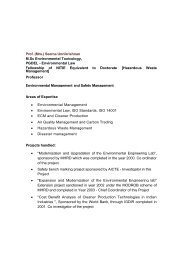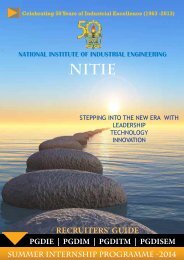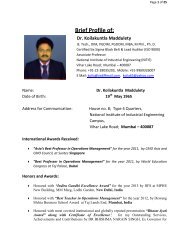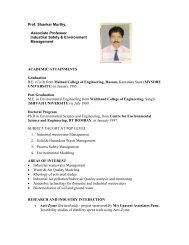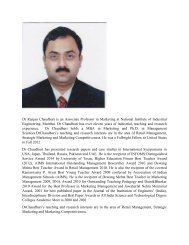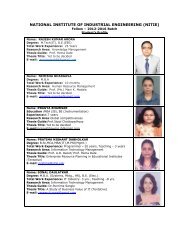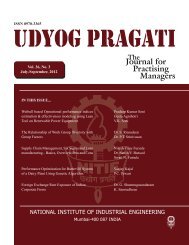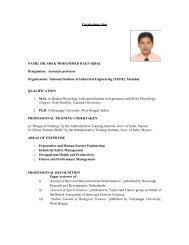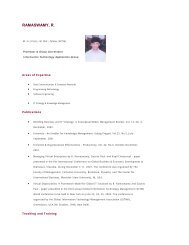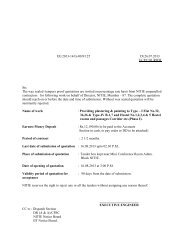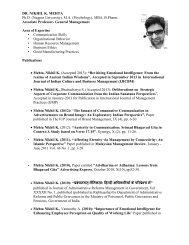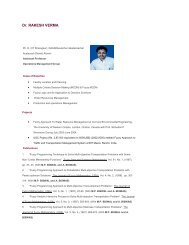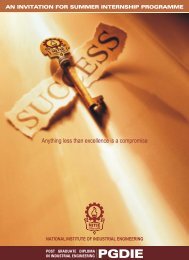Apr-Jun.12 - the Nitie
Apr-Jun.12 - the Nitie
Apr-Jun.12 - the Nitie
You also want an ePaper? Increase the reach of your titles
YUMPU automatically turns print PDFs into web optimized ePapers that Google loves.
A Conceptual Model for Gauging Overall Performance in Public Transport:<br />
A Case Study<br />
M.Vetrivel Sezhian * T.Nambirajan ***<br />
C.Muralidharan ** S.G.Deshmukh ****<br />
The case study presents a conceptual model aimed at<br />
gauging <strong>the</strong> overall performance of a public transport.<br />
<br />
consisting of eight models namely, fuzzy TOPSIS - fuzzy<br />
AHP multivariate analyses - which includes principal<br />
component analysis (PCA), discriminant analysis (DA), and<br />
multivariate analysis of variance (MANOVA); perceptual<br />
mapping (PM), performance importance matrix (PIM);<br />
and a composite model integrating conjoint analysis (CA)<br />
with <strong>the</strong> traditional QFD. This case study in a public sector<br />
passenger bus transport can incorporate two types of data<br />
namely; operational characteristics data and customers’ or<br />
passengers’ characteristics data.<br />
Key Words: Overall performance, Public transport, Fuzzy<br />
TOPSIS - fuzzy AHP, Principal component analysis,<br />
Discriminant analysis, MANOVA, PIM, Conjoint analysis,<br />
QFD.<br />
* Professor, Department of Mechanical Engineering,<br />
Dr. Paul’s Engineering College,<br />
Villupuram - 605109,<br />
TamilNadu, India<br />
vetrivel_sezhian@yahoo.co.in<br />
** Professor, Department of Manufacturing Engineering,<br />
Annamalai University,<br />
Chidambaram - 608002,<br />
TamilNadu, India<br />
muralre@yahoo.co.in<br />
*** Professor, Department of Management Studies,<br />
Pondicherry University,<br />
Pondicherry - 605014,<br />
Pondicherry, India<br />
rtnambirajan@gmail.com<br />
**** Professor, Department of Mechanical Engineering,<br />
Indian Institute of Technology Delhi,<br />
New Delhi - 110016, India<br />
deshmukhsg@hotmail.com<br />
Introduction<br />
In several Asian countries, <strong>the</strong> public sector occupies<br />
an important position in <strong>the</strong> economy. Bus is a very<br />
popular mode of transportation in India because of<br />
<br />
contribution to <strong>the</strong> national economy. In India, <strong>the</strong> state<br />
road transport undertaking (STRUs), with 58 members,<br />
form <strong>the</strong> backbone of mobility for urban and rural<br />
population across <strong>the</strong> country. They ply over 1,15,000<br />
buses, serving more than 65 million passengers a day<br />
and also providing employment directly to 0.8 million<br />
people (ASRTU).<br />
Effectiveness is <strong>the</strong> extent to which <strong>the</strong> output of<br />
service providers meets <strong>the</strong> objectives set for <strong>the</strong>m.<br />
<br />
uses its resources to produce outputs — that is, <strong>the</strong><br />
degree to which <strong>the</strong> observed use of resources matches<br />
<strong>the</strong> optimal use of resources, to produce outputs of a<br />
given quality. This can be assessed in terms of technical,<br />
<br />
2006). In short, effectiveness is about ‘doing <strong>the</strong> right<br />
<br />
(Svikis, 2003). Thus improving <strong>the</strong> performance of an<br />
<br />
A government sector service provider might increase <strong>the</strong><br />
<br />
of service; viz., a state transport undertaking might<br />
<br />
<strong>the</strong> same number of passengers. This could increase<br />
<br />
providing satisfactory outcomes for passengers and so,<br />
<strong>the</strong>re is a necessity to develop effectiveness indicators<br />
(Bhagavath, 2006). However, as it is serving a large<br />
amount of passengers, <strong>the</strong> quality of service is <strong>the</strong><br />
main concern of this issue. In <strong>the</strong> road transport sector<br />
Vol. 36, No. 2, <strong>Apr</strong>il-June, 2012<br />
42




